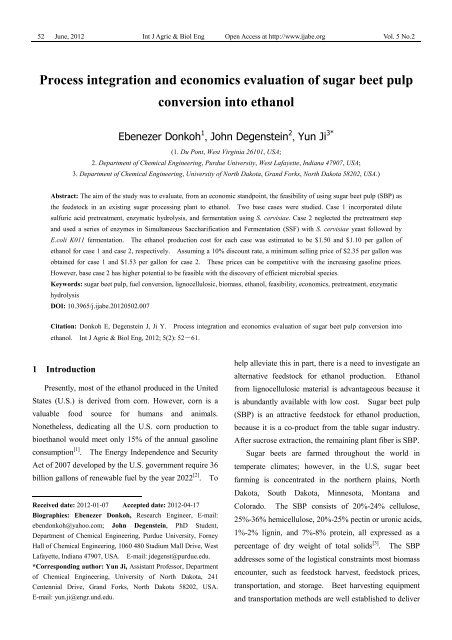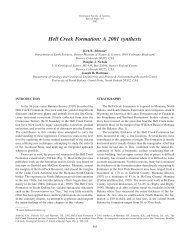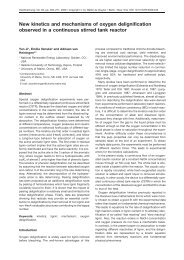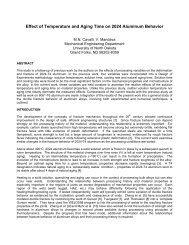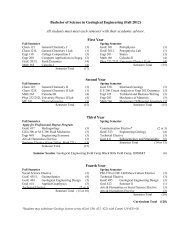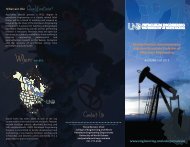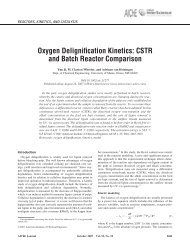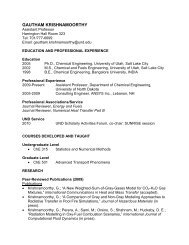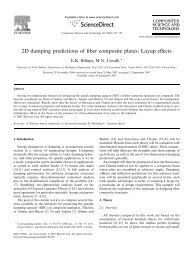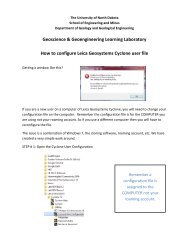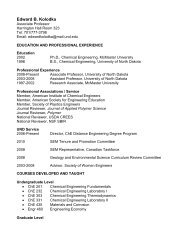Process integration and economics evaluation of sugar beet pulp ...
Process integration and economics evaluation of sugar beet pulp ...
Process integration and economics evaluation of sugar beet pulp ...
Create successful ePaper yourself
Turn your PDF publications into a flip-book with our unique Google optimized e-Paper software.
52 June, 2012 Int J Agric & Biol Eng Open Access at http://www.ijabe.org Vol. 5 No.2<br />
<strong>Process</strong> <strong>integration</strong> <strong>and</strong> <strong>economics</strong> <strong>evaluation</strong> <strong>of</strong> <strong>sugar</strong> <strong>beet</strong> <strong>pulp</strong><br />
conversion into ethanol<br />
Ebenezer Donkoh 1 , John Degenstein 2 , Yun Ji 3*<br />
(1. Du Pont, West Virginia 26101, USA;<br />
2. Department <strong>of</strong> Chemical Engineering, Purdue University, West Lafayette, Indiana 47907, USA;<br />
3. Department <strong>of</strong> Chemical Engineering, University <strong>of</strong> North Dakota, Gr<strong>and</strong> Forks, North Dakota 58202, USA.)<br />
Abstract: The aim <strong>of</strong> the study was to evaluate, from an economic st<strong>and</strong>point, the feasibility <strong>of</strong> using <strong>sugar</strong> <strong>beet</strong> <strong>pulp</strong> (SBP) as<br />
the feedstock in an existing <strong>sugar</strong> processing plant to ethanol. Two base cases were studied. Case 1 incorporated dilute<br />
sulfuric acid pretreatment, enzymatic hydrolysis, <strong>and</strong> fermentation using S. cervisiae. Case 2 neglected the pretreatment step<br />
<strong>and</strong> used a series <strong>of</strong> enzymes in Simultaneous Saccharification <strong>and</strong> Fermentation (SSF) with S. cervisiae yeast followed by<br />
E.coli K011 fermentation. The ethanol production cost for each case was estimated to be $1.50 <strong>and</strong> $1.10 per gallon <strong>of</strong><br />
ethanol for case 1 <strong>and</strong> case 2, respectively. Assuming a 10% discount rate, a minimum selling price <strong>of</strong> $2.35 per gallon was<br />
obtained for case 1 <strong>and</strong> $1.53 per gallon for case 2. These prices can be competitive with the increasing gasoline prices.<br />
However, base case 2 has higher potential to be feasible with the discovery <strong>of</strong> efficient microbial species.<br />
Keywords: <strong>sugar</strong> <strong>beet</strong> <strong>pulp</strong>, fuel conversion, lignocellulosic, biomass, ethanol, feasibility, <strong>economics</strong>, pretreatment, enzymatic<br />
hydrolysis<br />
DOI: 10.3965/j.ijabe.20120502.007<br />
Citation: Donkoh E, Degenstein J, Ji Y. <strong>Process</strong> <strong>integration</strong> <strong>and</strong> <strong>economics</strong> <strong>evaluation</strong> <strong>of</strong> <strong>sugar</strong> <strong>beet</strong> <strong>pulp</strong> conversion into<br />
ethanol. Int J Agric & Biol Eng, 2012; 5(2): 52-61.<br />
1 Introduction <br />
Presently, most <strong>of</strong> the ethanol produced in the United<br />
States (U.S.) is derived from corn. However, corn is a<br />
valuable food source for humans <strong>and</strong> animals.<br />
Nonetheless, dedicating all the U.S. corn production to<br />
bioethanol would meet only 15% <strong>of</strong> the annual gasoline<br />
consumption [1] . The Energy Independence <strong>and</strong> Security<br />
Act <strong>of</strong> 2007 developed by the U.S. government require 36<br />
billion gallons <strong>of</strong> renewable fuel by the year 2022 [2] . To<br />
Received date: 2012-01-07 Accepted date: 2012-04-17<br />
Biographies: Ebenezer Donkoh, Research Engineer, E-mail:<br />
ebendonkoh@yahoo.com; John Degenstein, PhD Student,<br />
Department <strong>of</strong> Chemical Engineering, Purdue University, Forney<br />
Hall <strong>of</strong> Chemical Engineering, 1060 480 Stadium Mall Drive, West<br />
Lafayette, Indiana 47907, USA. E-mail: jdegenst@purdue.edu.<br />
*Corresponding author: Yun Ji, Assistant Pr<strong>of</strong>essor, Department<br />
<strong>of</strong> Chemical Engineering, University <strong>of</strong> North Dakota, 241<br />
Centennial Drive, Gr<strong>and</strong> Forks, North Dakota 58202, USA.<br />
E-mail: yun.ji@engr.und.edu.<br />
help alleviate this in part, there is a need to investigate an<br />
alternative feedstock for ethanol production. Ethanol<br />
from lignocellulosic material is advantageous because it<br />
is abundantly available with low cost. Sugar <strong>beet</strong> <strong>pulp</strong><br />
(SBP) is an attractive feedstock for ethanol production,<br />
because it is a co-product from the table <strong>sugar</strong> industry.<br />
After sucrose extraction, the remaining plant fiber is SBP.<br />
Sugar <strong>beet</strong>s are farmed throughout the world in<br />
temperate climates; however, in the U.S, <strong>sugar</strong> <strong>beet</strong><br />
farming is concentrated in the northern plains, North<br />
Dakota, South Dakota, Minnesota, Montana <strong>and</strong><br />
Colorado. The SBP consists <strong>of</strong> 20%-24% cellulose,<br />
25%-36% hemicellulose, 20%-25% pectin or uronic acids,<br />
1%-2% lignin, <strong>and</strong> 7%-8% protein, all expressed as a<br />
percentage <strong>of</strong> dry weight <strong>of</strong> total solids [3] . The SBP<br />
addresses some <strong>of</strong> the logistical constraints most biomass<br />
encounter, such as feedstock harvest, feedstock prices,<br />
transportation, <strong>and</strong> storage. Beet harvesting equipment<br />
<strong>and</strong> transportation methods are well established to deliver
June, 2012 <strong>Process</strong> <strong>integration</strong> <strong>and</strong> <strong>economics</strong> <strong>evaluation</strong> <strong>of</strong> <strong>sugar</strong> <strong>beet</strong> <strong>pulp</strong> conversion into ethanol Vol. 5 No.2 53<br />
the product to the <strong>sugar</strong> processing plant. After sucrose<br />
extraction, the remaining <strong>pulp</strong> is dried, pelletized, <strong>and</strong><br />
sold to farmers as animal feed. Doran <strong>and</strong> Foster [4]<br />
estimated that between 30%-40% <strong>of</strong> the overall energy<br />
cost <strong>of</strong> <strong>sugar</strong> <strong>beet</strong> processing is devoted to dehydrating<br />
<strong>and</strong> pelletizing the <strong>pulp</strong>. Consequently, because SBP<br />
would not need to be dried, the use <strong>of</strong> SBP as an ethanol<br />
feedstock could be more pr<strong>of</strong>itable than processing for<br />
animal feed. The <strong>sugar</strong> <strong>beet</strong> industry already has many<br />
built-in production advantages that favor the production<br />
<strong>of</strong> high performance fuels at existing <strong>sugar</strong> <strong>beet</strong><br />
processing plants. First, there are large quantities <strong>of</strong><br />
SBP already concentrated with no additional<br />
transportation cost. Second, energy consumption would<br />
be minimal. In the past, much attention was paid to<br />
pretreatment [5-7] , enzymatic hydrolysis [8-10] , <strong>and</strong><br />
fermentation [11-13] stages. This work combines all <strong>of</strong> the<br />
aforementioned stages.<br />
The National Renewable Energy Resource Laboratory<br />
(NREL) has conducted a number <strong>of</strong> feasibility studies on<br />
lignocellulosic biomass materials to ethanol processes,<br />
primarily with corn stover [14,15] . Also NREL has<br />
investigated the feasibility <strong>of</strong> integrating lignocellulosic<br />
ethanol into existing corn based ethanol plants [16] .<br />
Nguyen <strong>and</strong> Saddle [17] used process simulation models to<br />
evaluate the technical <strong>and</strong> economic feasibility <strong>of</strong> a<br />
lignocellulosic to ethanol bioconversion process using<br />
aspen wood. Outlaw et al. [18] analyzed the feasibility <strong>of</strong><br />
integrating ethanol production into the existing <strong>sugar</strong> mill<br />
that uses <strong>sugar</strong>cane juice as the feedstock for ethanol<br />
production.<br />
The objective <strong>of</strong> the present work was to investigate<br />
the feasibility <strong>of</strong> integrating an ethanol producing plant<br />
into an existing <strong>sugar</strong> processing plant that uses SBP as<br />
feedstock. The primary idea was after sucrose<br />
extraction, the remaining <strong>pulp</strong> at 75% (W/W) moisture<br />
would be transported to the integrated ethanol plant.<br />
The energy previously used to dry <strong>and</strong> pelletize the <strong>pulp</strong><br />
would be diverted to operate the ethanol plant. The<br />
benefit <strong>of</strong> conducting this research is to show the<br />
feasibility <strong>of</strong> using SBP as feedstock over corn stover <strong>and</strong><br />
ultimately to corn starch.<br />
2 Materials <strong>and</strong> methods<br />
The development <strong>of</strong> process flow diagrams is the first<br />
step in any conceptual process design. Because <strong>of</strong> the<br />
complexity <strong>of</strong> lignocellulosic ethanol production, there is<br />
a variety <strong>of</strong> processing conceptual designs presented in<br />
the literature. Two process flowsheets from the<br />
literature were used in this study. The first is by<br />
NREL [14] <strong>and</strong> the second is by Rorick [19] . The processes<br />
were modeled using ASPEN Plus simulation s<strong>of</strong>tware.<br />
This s<strong>of</strong>tware was used to solve the mass <strong>and</strong> energy<br />
balances <strong>and</strong> to calculate thermodynamic properties <strong>of</strong><br />
the streams in the process. The component physical<br />
properties used in the simulation were obtained from<br />
Wooley & Putsche [20] . The properties not directly<br />
available were estimated from similar components.<br />
Material balances were used to size major equipment.<br />
Total project investments were determined for both cases.<br />
We used a discounted cash flow analysis to determine the<br />
production cost <strong>of</strong> ethanol when the net present value <strong>of</strong><br />
the project was zero for both cases.<br />
American Crystal Sugar, which is owned by<br />
approximately 3 000 shareholders, planted about 443 000<br />
acres <strong>of</strong> <strong>sugar</strong> <strong>beet</strong>s resulting in about 10 million tons <strong>of</strong><br />
<strong>sugar</strong> <strong>beet</strong>s in 2010 [21] . Their processing plant in East<br />
Gr<strong>and</strong> Forks, Minnesota, one <strong>of</strong> the five in the Red River<br />
Valley, h<strong>and</strong>les an average <strong>of</strong> 2 300 000 tons <strong>of</strong> <strong>sugar</strong><br />
<strong>beet</strong>s annually [22] . For a typical <strong>sugar</strong> <strong>beet</strong> processing<br />
plant, 250 kg <strong>of</strong> pressed <strong>beet</strong> <strong>pulp</strong> with 75% moisture<br />
remain after the removal <strong>of</strong> sucrose from one ton <strong>of</strong> <strong>sugar</strong><br />
<strong>beet</strong>s, equivalent to about 62.5 kg <strong>of</strong> dry matter <strong>beet</strong> <strong>pulp</strong><br />
material [10] . As a result, the plant is assumed to operate<br />
at 574 990 MT <strong>of</strong> SBP per year.<br />
2.1 Experiment<br />
2.1.1 Compositional analysis<br />
The SBP was provided by American Crystal Sugar<br />
(East Gr<strong>and</strong> Forks, MN 56721). Compositional analysis<br />
<strong>of</strong> the SBP was determined based on National Renewable<br />
Energy Laboratory Analytical Procedure (NREL/<br />
TP-510-42619).<br />
2.1.2 Pretreatment<br />
There are many types <strong>of</strong> pretreatment processes but<br />
one unifying goal is to get the highest fermentable <strong>sugar</strong>
54 June, 2012 Int J Agric & Biol Eng Open Access at http://www.ijabe.org Vol. 5 No.2<br />
conversion possible after enzymatic hydrolysis. Dilute<br />
sulfuric acid pretreatment was used in this study because<br />
it has been widely used <strong>and</strong> relatively inexpensive <strong>and</strong><br />
effective to treat different biomass species [23] . In<br />
addition, this will hydrolyze the amorphous polymeric<br />
hemicellulose into monomeric saccharides in the<br />
hydrolyzate <strong>and</strong> thus improves the cellulose accessibility<br />
to enzymes during enzymatic hydrolysis [24, 25] .<br />
Pretreatments were performed in a 300 mL internal<br />
volume batch reactor manufactured by Autoclave<br />
Engineers (Erie, PA 16509). The reactor was fabricated<br />
with Hastelloy ® C-276 because this alloy is highly<br />
resistant to acid corrosion in high temperature<br />
environment. Reactor was equipped with external jacket<br />
for heating <strong>and</strong> cooling. Saturated steam <strong>and</strong> cold water<br />
were used as heating <strong>and</strong> cooling elements. The average<br />
heating kinetics <strong>of</strong> the reactor was around 35℃/min.<br />
Details <strong>of</strong> the novel pretreatment reactor can be found at<br />
the work <strong>of</strong> Degenstein et al. [26] . The agitation was<br />
performed by magnetic motor <strong>and</strong> was maintained<br />
constant at 60 r/min throughout the reaction period.<br />
Steam was injected into the reactor from the boiler by<br />
operating a three-way valve manually. The reaction<br />
time was initiated when the desired temperature was<br />
reached in the reactor. After completion <strong>of</strong> the reaction<br />
pretreatment run, steam was shut <strong>of</strong>f <strong>and</strong> cooling water<br />
was pumped into the external jacket <strong>of</strong> the reactor.<br />
Once the reactor was cooled down below 40℃, slurry<br />
samples were withdrawn from the reactor into<br />
polyethylene bottles for further analysis.<br />
2.1.3 Enzymatic hydrolysis<br />
Enzymatic hydrolysis <strong>of</strong> the pretreated solids was<br />
performed in a MaxQ 4000 thermal incubator<br />
manufactured by Thermo Scientific (Portsmouth, NH<br />
03801) at 50℃ at 250 r/min for 72 h. Hydrolysis was<br />
performed with sodium citrate buffer with 50 mM L -1<br />
concentration (pH <strong>of</strong> 4.8) <strong>and</strong> sodium azide with<br />
concentration <strong>of</strong> 20 g/mL. These reagents along with<br />
de-ionized (DI) water were added to the 1.5% dry<br />
substrate <strong>of</strong> glucan so that total volume <strong>of</strong> the batch was<br />
10 mL. A commercially available enzyme GC220<br />
(Genencor, Palo Alto CA) with loading <strong>of</strong> 20 mg <strong>of</strong><br />
protein/g <strong>of</strong> cellulose was used to perform enzymatic<br />
hydrolysis. After hydrolysis, samples were filtered <strong>and</strong><br />
analyzed in HPLC for fermentable <strong>sugar</strong> yields. The<br />
cellulose digestion was calculated by using the Equation<br />
(1). The value 0.9 was used in the equation as a<br />
correction factor for hydration.<br />
Grams <strong>of</strong> cellulose digested0.9100<br />
% Digestion<br />
Grams <strong>of</strong> cellulose added<br />
(1)<br />
2.1.4 Analytical procedure<br />
Pretreated slurry samples were vacuum filtered <strong>and</strong><br />
separated into Water Insoluble Solids (WIS) <strong>and</strong> Water<br />
Soluble Carbohydrates (WSC). The WSC were<br />
analyzed for monosaccharides <strong>and</strong> inhibitor products.<br />
This analysis was performed based on the NREL<br />
analytical procedures (NREL/TP-510-42623). The WIS<br />
were analyzed for glucan, xylan, <strong>and</strong> acid insoluble lignin<br />
(AIL) content. Quantitative analysis for determining<br />
monosaccharides present in WSC was performed by<br />
Agilent 1200 HPLC with Transgenomic CHO-Pb column.<br />
All samples were replicated <strong>and</strong> analyzed for 30 minutes<br />
in HPLC. The mobile phase used for analysis was DI<br />
water with a flow rate <strong>of</strong> 0.6 mL/min.<br />
2.2 Case 1 process description<br />
Aden et al. [15] developed a process flowsheet for<br />
conversion <strong>of</strong> biomass to ethanol. Figure 1 is a<br />
simplified version <strong>of</strong> their model, which was used as the<br />
base case for producing ethanol from SBP. Slight<br />
alterations <strong>of</strong> NREL’s model were done as the feed<br />
h<strong>and</strong>ling section was eliminated because SBP does not<br />
require a preparation step prior to pretreatment. Also<br />
the cellulose production section was removed. We<br />
assumed that purchasing the enzymes from vendors<br />
would be economical. Furthermore, we assumed that<br />
the plant will produce only ethanol. In NREL’s model,<br />
they dehydrated <strong>and</strong> burned the remaining slurry after<br />
distillation in a boiler to generate steam <strong>and</strong> electricity [23] .<br />
The slurry mainly consists <strong>of</strong> lignin. The benefits<br />
gained from producing electricity would be <strong>of</strong>fset by the<br />
cost <strong>of</strong> dehydrating the slurry. Most biomass consists <strong>of</strong><br />
10%-30% lignin while SBP contains 1%-2% lignin [10] .<br />
Dehydrating <strong>and</strong> burning the slurry to produce electricity<br />
was not considered in this study. A waste water<br />
treatment section was also not considered in the ASPEN
June, 2012 <strong>Process</strong> <strong>integration</strong> <strong>and</strong> <strong>economics</strong> <strong>evaluation</strong> <strong>of</strong> <strong>sugar</strong> <strong>beet</strong> <strong>pulp</strong> conversion into ethanol Vol. 5 No.2 55<br />
plus model since the existing <strong>sugar</strong> processing plant had a<br />
water treatment facility in place <strong>and</strong> it was assumed to<br />
have the capacity to treat the waste output from the<br />
integrated plant.<br />
Figure 1<br />
<strong>Process</strong> flowsheet diagram for base case 1 (SBP is <strong>sugar</strong> <strong>beet</strong> <strong>pulp</strong> as the feedstock , S/L is solid/liquid separation step)<br />
The process flowsheet shown in Figure 1 was used in<br />
the ASPEN Plus simulation <strong>of</strong> the plant. After sucrose<br />
extraction, the remaining <strong>pulp</strong> is transferred to the<br />
pretreatment section. For a typical biomass to ethanol<br />
conversion process, pretreatment is used to combat the<br />
recalcitrant nature <strong>of</strong> the biomass [6] . The main objective<br />
<strong>of</strong> the dilute acid <strong>and</strong> high temperature pretreatment is to<br />
solubilize the hemicellulosic fraction <strong>of</strong> the biomass.<br />
Moreover, some <strong>of</strong> the lignin in the feedstock is also<br />
solubilized [7] . As a result, cellulose is more susceptible<br />
to enzymatic attack. The glucan in the hemicelluloses<br />
<strong>and</strong> a small portion <strong>of</strong> the cellulose also are converted to<br />
glucose. Degradation products such as: pentose <strong>sugar</strong>s<br />
(primarily furfural), hexose <strong>sugar</strong>s (primarily<br />
hydroxymethyl furfural), <strong>and</strong> acetic acid are formed<br />
during pretreatment [15] .<br />
The data generated from the 300 mL Hastelloy ®<br />
C-276 batch reactor was used in the ASPEN Plus<br />
simulation. The SBP pretreatment was conducted at<br />
150℃ with 1.1% sulfuric acid <strong>and</strong> 10% solid loading for<br />
a total residence time <strong>of</strong> 12 minutes. The pretreatment<br />
temperature was selected based on the equipment<br />
capability <strong>and</strong> previous study [27] . The temperature used<br />
is lower than that would be used commercially. A<br />
longer residence time was used to <strong>of</strong>fset the lower<br />
temperature. Five percent <strong>of</strong> glucan is converted to<br />
glucose, 60% <strong>of</strong> xylan, <strong>and</strong> 55% <strong>of</strong> arabinan are<br />
converted to their respective <strong>sugar</strong>s under these<br />
conditions. A small residence time is preferred for the<br />
commercial plant because the pretreatment reactor is<br />
expensive.<br />
Therefore, we modeled the pretreatment<br />
based on recommendations made by Aden et al. [15] .<br />
The<br />
<strong>pulp</strong> was treated with 1.1% dilute sulfuric acid at 190℃<br />
with a residence time <strong>of</strong> two minutes.<br />
We measured the<br />
yield using our lab scale equipment (300 mL reactor).<br />
We also assumed that yields similar to our experiments<br />
would be achieved at this elevated temperature with the<br />
shorter residence time at commercial scale.<br />
These<br />
yields from the experiments were used in the process<br />
simulation.<br />
After pretreatment, the effluent is flash-cooled to<br />
remove the degradation products detrimental to<br />
downstream fermentation microorganisms.<br />
Some <strong>of</strong><br />
acetic acid <strong>and</strong> most <strong>of</strong> 5-hydroxy-2-methylfurfural HMF<br />
<strong>and</strong> furfural are removed.<br />
In addition, the liquid is<br />
separated from the solid <strong>and</strong> treated by addition <strong>of</strong> lime.<br />
Overliming is a temperature <strong>and</strong> pH treatment designed to<br />
aid the conversion <strong>of</strong> hydrolyzed <strong>sugar</strong>s to ethanol during<br />
fermentation [15] .<br />
For efficient organism <strong>sugar</strong> uptake, it<br />
is necessary for minimum concentrations <strong>of</strong> calcium.<br />
Overliming limits calcium concentration to tolerable<br />
levels [14] .<br />
The hydrolyzate is adjusted to pH 4.8 with<br />
sodium hydroxide <strong>and</strong> the resulting gypsum is separated<br />
<strong>and</strong> discarded.<br />
The conditioned liquid is mixed with the<br />
solid stream <strong>and</strong> fed to the enzymatic hydrolysis reactor.<br />
In the hydrolysis step, water was added to bring the<br />
hydrolysis total solids to 20%. Though the lab scale<br />
pretreatment experiments were conducted at 10% solid<br />
due to equipment constrain. Due to the SBP’s low<br />
bulk density, 20% was achievable in the experimental
56 June, 2012 Int J Agric & Biol Eng Open Access at http://www.ijabe.org Vol. 5 No.2<br />
apparatus. For this feasibility studies, we assumed<br />
similar results would be achieved at 20% solid loading<br />
at a commercial scale. This step was modeled as<br />
simultaneous saccharification <strong>and</strong> co-fermentation<br />
(SSCF). This configuration allows the hydrolysis step<br />
to be operated at the enzymes optimal operating<br />
temperature. The hydrolysis section was modeled<br />
using a continuous reactor at 50℃ with a total residence<br />
time <strong>of</strong> 36 hours. The cellulase enzyme (GC220) with<br />
a protein content <strong>of</strong> 212 mg protein/L was diluted with<br />
water <strong>and</strong> fed to the reactor with enzyme loading <strong>of</strong><br />
20 mg/g <strong>of</strong> cellulose. The data used in the simulation<br />
was obtained from this laboratory work. Enzymatic<br />
hydrolysis <strong>of</strong> SBP was conducted in 125 mL Erlenmeyer<br />
flasks with enzyme loading <strong>of</strong> 20 mg/g <strong>of</strong> cellulose <strong>and</strong><br />
SBP solid loading <strong>of</strong> 1.5% for 72 hours. Fifty-five<br />
percent <strong>of</strong> the glucose hydrolyzed during the first<br />
34 hours <strong>and</strong> 80% after 72 hours. We assumed that<br />
similar yields would be achieved at a larger scale.<br />
Therefore, we used the obtained yields in the simulation.<br />
Enzyme recycle was not considered in this study<br />
because it had the potential to build up degradation<br />
products in the process.<br />
After 36 hours, the slurry was cooled to 31℃ <strong>and</strong> fed<br />
to the fermentation tank. The fermentation process was<br />
modeled with a continuous reactor at 31℃ with 36 hours<br />
<strong>of</strong> residence time. It was assumed that saccharification<br />
would continue during the fermentation step; however, at<br />
a slower rate. Saccharomyces cerevisiae was added to<br />
the reactor to ferment glucose to ethanol. This organism<br />
was selected for its ability to ferment glucose at<br />
industrious scale <strong>and</strong> for its high ethanol tolerance.<br />
Saccharomyces cerevisiaes achieve lower yield due to the<br />
organism inability to ferment arabinose <strong>and</strong> galacturonic<br />
acid from SBP [12] . In the simulation, 20% ethanol yield<br />
based on glucose was used. The yield used in the<br />
simulation was obtained from laboratory work done by<br />
Rorick [19] . In addition to ethanol, acetic acid, <strong>and</strong> CO 2<br />
were also produced.<br />
The product recovery section consists <strong>of</strong> two<br />
distillation columns <strong>and</strong> a molecular sieve. The first<br />
column removes most <strong>of</strong> the dissolved CO 2 <strong>and</strong> most <strong>of</strong><br />
the water. The second column concentrates the ethanol<br />
to a near azeotropic composition.<br />
Molecular sieves<br />
further remove the water present in the azeotropic<br />
mixture.<br />
A water scrubber recovered most <strong>of</strong> the<br />
ethanol in the fermentation vents.<br />
<strong>and</strong> sent to storage tank.<br />
2.3 Case 2 process description<br />
The ethanol is cooled<br />
For the second base case, we assumed the same plant<br />
capacity (574 990 MT per year) as case 1.<br />
In case 2, the<br />
pretreatment section was removed from the process<br />
flowsheet.<br />
The main purpose <strong>of</strong> pretreatment is to<br />
remove the lignin barrier in biomass.<br />
contains 1%-2% lignin.<br />
remove the pretreatment section [3] .<br />
However, SBP<br />
Therefore, it is economical to<br />
The SBP contains<br />
20%-25% pectin. The presence <strong>of</strong> pectin forms a barrier<br />
that reduces cellulose susceptibility to enzymatic attack.<br />
As a result, pectinase was added to hydrolyze the pectin<br />
portion.<br />
to model this case.<br />
ASPEN Plus simulation s<strong>of</strong>tware was also used<br />
the flowsheet shown in Figure 2.<br />
The simulation model was based on<br />
The model consists <strong>of</strong><br />
a simultaneous saccharification <strong>and</strong> fermentation (SSF)<br />
section, followed by another fermentation step, <strong>and</strong> then a<br />
product recovery section. The data used in the<br />
simulation were obtained from laboratory work<br />
conducted by Rorick [19] . Rorick [19] investigated<br />
maximizing ethanol titers <strong>and</strong> yields through enzymatic<br />
hydrolysis <strong>of</strong> SBP <strong>and</strong> fermentation <strong>of</strong> the five <strong>and</strong> six<br />
carbon <strong>sugar</strong>s.<br />
Hemicellulose <strong>and</strong> pectin were also<br />
hydrolyzed <strong>and</strong> fermented separately from cellulose to<br />
increase ethanol titers <strong>and</strong> yields.<br />
Figure 2 <strong>Process</strong> flowsheet diagram for base case 2 (SSF is<br />
simultaneous saccharification <strong>and</strong> fermentation, SBP is <strong>sugar</strong> <strong>beet</strong><br />
<strong>pulp</strong> as the feedstock)<br />
The SSF section was modeled with two continuous<br />
stirred reactors in series operating at 39℃. The SBP<br />
was treated with pectinases, cellulases, <strong>and</strong> S. cerivisiae<br />
organisms. Pectinase hydrolyzed the pectin <strong>and</strong> the
June, 2012 <strong>Process</strong> <strong>integration</strong> <strong>and</strong> <strong>economics</strong> <strong>evaluation</strong> <strong>of</strong> <strong>sugar</strong> <strong>beet</strong> <strong>pulp</strong> conversion into ethanol Vol. 5 No.2 57<br />
hemicellulose portion <strong>of</strong> the biomass to galacturonic acid<br />
<strong>and</strong> mostly arabinose. Cellulase hydrolyzed the<br />
cellulose portion to glucose. Cellubiases was added to<br />
hydrolyze the remaining cellulose in the SBP completely.<br />
Saccharomyces cerivisiae fermented the resulting glucose<br />
to ethanol. The enzymes <strong>and</strong> organisms have different<br />
optimal temperatures. We assumed that 20% yield<br />
based on glucose <strong>and</strong> 21% yield based on hemicellulose<br />
was achievable at the industrial scale based on the lab<br />
scale data from Rorick [19] <strong>and</strong> used it in the simulation.<br />
After a total residence time <strong>of</strong> 72 hours, the slurry was<br />
sent to the E. coli fermentation section. Saccharomyces<br />
cerevisiae organism performs well when converting<br />
glucose to ethanol. However, it cannot convert the<br />
arabinose <strong>and</strong> galacturonic acid portions, which accounts<br />
for 42% <strong>of</strong> SBP to ethanol. Escherichia coli KO11 (E.<br />
coli KO11), on the other h<strong>and</strong>, can convert both arabinose<br />
<strong>and</strong> galacturonic acid to ethanol. Therefore, E. coli<br />
KO11 organism was fed to two continuous stirred tanks<br />
in series at 37℃ for an additional 72 hours. Please<br />
note E. coli can survive in an ethanol solution generated<br />
by yeast. However, the yield may be lowered due to the<br />
presence <strong>of</strong> inhibitors <strong>and</strong> ethanol concentration.<br />
2.4 Theory <strong>and</strong> calculation<br />
The component stream balances were used to size the<br />
major process equipments. Most <strong>of</strong> the equipment costs<br />
used in this study were obtained from Humbird et al. [27] .<br />
The pretreatment reactor was estimated using Guthrie’s<br />
purchase cost correlation [28] . Due to the presence <strong>of</strong><br />
sulfuric acid <strong>and</strong> elevated temperatures in case 1,<br />
Hastelloy C Alloy was selected as the material <strong>of</strong><br />
construction for the pretreatment reactor to combat<br />
corrosion effect.<br />
New Size <br />
New Cost Original Cost <br />
Original Size <br />
(2)<br />
Equation (2) was used to adjust the equipment costs<br />
for other alternative sizes being evaluated. The scaling<br />
exponents (exp) were obtained from Ulrich [29] <strong>and</strong> Aden<br />
et al. [15] . The equipment installation factors used in this<br />
study were obtained from Peters & Timmerhaus [30] .<br />
Using the Chemical Engineering Purchased Equipment<br />
Index, the equipment costs were adjusted to the projected<br />
exp<br />
year. Accessible values for the index ranging from 1990<br />
to 2008 were regressed to a simple equation.<br />
The<br />
generated equation was used to extrapolate to future years.<br />
Once the total installed equipment cost (TIEC) was<br />
determined, other costs associated with the project were<br />
added: such as warehouse, construction cost, <strong>and</strong> start-up<br />
cost.<br />
We assumed the cost <strong>of</strong> warehouse, construction<br />
<strong>and</strong> start-up to be 1.50%, 10%, <strong>and</strong> 8% <strong>of</strong> TIEC,<br />
respectively. Summation <strong>of</strong> the above costs gives the total<br />
project investment.<br />
Raw materials quantities used in determining the<br />
operating cost were obtained from the ASPEN Plus<br />
model.<br />
NREL [15] .<br />
The costs <strong>of</strong> the materials were obtained from<br />
The costs <strong>of</strong> chemicals associated with the<br />
process were indexed to the projected year using the<br />
Industrial Inorganic Chemical Index. The fixed<br />
operating cost includes labor cost <strong>and</strong> various overhead<br />
items.<br />
Overhead items consist <strong>of</strong> general overhead,<br />
maintenance, insurance, <strong>and</strong> taxes.<br />
Applying guidelines<br />
presented by Douglas [28] , it was assumed the general<br />
overhead to be 60% <strong>of</strong> the total salaries, maintenance to<br />
be 2% <strong>of</strong> installed equipment cost, insurance, <strong>and</strong> taxes to<br />
be 1.50% <strong>of</strong> the total installed equipment cost.<br />
The<br />
labor costs were indexed to the operating year using the<br />
labor index from the Bureau <strong>of</strong> Labor Statistics [31] .<br />
available data were regressed to a simple equation.<br />
The<br />
The<br />
regression equation was used to extrapolate to the<br />
assumed projected year.<br />
Discounted cash flow analysis was used to determine<br />
the minimum selling price per gallon <strong>of</strong> ethanol produced<br />
for both cases based upon the total project investment,<br />
variable operating costs, <strong>and</strong> fixed operating cost.<br />
Micros<strong>of</strong>t Office Excel 2007 solver was used to iterate on<br />
the selling price <strong>of</strong> ethanol until the net present value <strong>of</strong><br />
the project is zero.<br />
The assumptions used to evaluate the discounted cash<br />
flow rate <strong>of</strong> return (DCFROR) analysis are listed in Table<br />
1. Double declining balance (DDB) depreciation<br />
method was used for the income tax calculation. This<br />
was used because it provides greater returns at the early<br />
stages <strong>of</strong> the project. The discount rate for this analysis<br />
was set at 10%. The assumptions presented in Table 1<br />
are based on the recommendations made by Short [32] on
58 June, 2012 Int J Agric & Biol Eng Open Access at http://www.ijabe.org Vol. 5 No.2<br />
how to perform economic <strong>evaluation</strong> <strong>of</strong> renewable energy<br />
technologies. He recommended using a discount rate <strong>of</strong><br />
10% in the absence <strong>of</strong> statistical data on discount rates<br />
used by industrial, transportation, <strong>and</strong> commercial<br />
investors for investments with risks similar to those <strong>of</strong><br />
conservation <strong>and</strong> renewable energy investments.<br />
Table 1 DCFROR assumptions for the two base cases<br />
Plant life<br />
20 years<br />
Salvage Value 0<br />
Depreciation Method<br />
DDB<br />
Depreciation Periods<br />
7 years<br />
Income Tax Rate 39%<br />
Discount Rate 10%<br />
Working Capital 10%<br />
3 Results <strong>and</strong> discussion<br />
3.1 Economic <strong>evaluation</strong><br />
We present results <strong>of</strong> an economic <strong>evaluation</strong> <strong>of</strong><br />
integrating a lignocellulosic ethanol plant into an existing<br />
<strong>sugar</strong> processing plant using SBP as the feedstock. We<br />
assumed that the energy saved from omitting the SBP<br />
dehydrating <strong>and</strong> pelletizing steps would be used to<br />
operate the plant. As a result, utilities were not<br />
considered in this work. Two base cases were<br />
considered <strong>and</strong> their results are presented.<br />
All <strong>of</strong> the costs reported in this study were in 2012<br />
US dollars. The plant capacity for both base cases was<br />
574 990 MT <strong>of</strong> SBP per year. The overall production<br />
capacity for base case 1 was 1.7 million gallons per year<br />
<strong>and</strong> 2.26 million gallons <strong>of</strong> ethanol per year for case 2.<br />
The observed difference in the production capacity is due<br />
to the yields achieved at the enzymatic hydrolysis <strong>and</strong><br />
fermentation stages.<br />
Table 2 summarizes the capital requirements <strong>and</strong><br />
percentage breakdown <strong>of</strong> installed equipments costs for<br />
both examined cases. For case 1, the pretreatment <strong>and</strong><br />
distillation sections were the largest contributors to the<br />
total direct cost <strong>and</strong> together represented 84% <strong>of</strong> the total<br />
direct cost. The total project investment was estimated<br />
to be $11.4 million for base case 1 <strong>and</strong> $6.4 million for<br />
case 2. The total capital investment (TPI) for case 2 is<br />
50% less than that <strong>of</strong> case 1. This is not surprising,<br />
considering that the pretreatment section representing<br />
55% <strong>of</strong> the total direct cost that was not considered in<br />
case 2.<br />
The overall ethanol production cost for the base cases<br />
were estimated to be $1.50 <strong>and</strong> $1.10 per gallon <strong>of</strong><br />
ethanol for case 1 <strong>and</strong> case 2, respectively.<br />
The<br />
production cost in case 1 is 37% higher than in case 2,<br />
because case 1 has a lower production capacity <strong>and</strong><br />
higher capital investment.<br />
Direct cost<br />
Table 2<br />
Total project investment (2012 dollars)<br />
Case 1<br />
TDC<br />
/%<br />
Pretreatment $5 238 500 55<br />
Enzymatic hydrolysis $53 000 7<br />
Case 2<br />
Fermentation $789 100 8 $2 520 300 48<br />
Distillation $2 774 200 29 $2 774 200 52<br />
Total direct cost (TDC) $9 453 900 $5 294 500<br />
Indirect costs $1 101 400 $616 800<br />
Other costs $844 400 $472 900<br />
Total project investment $11 399 700 $6 384 200<br />
TDC<br />
/%<br />
The fixed <strong>and</strong> variable operating costs are presented<br />
in Table 3.<br />
The maintenance, taxes, <strong>and</strong> overhead costs<br />
are based on guidelines presented by Peters &<br />
Timmerhaus [30] .<br />
The Table presents total annual costs<br />
<strong>and</strong> cost per gallon <strong>of</strong> ethanol for both base cases.<br />
expected, case 2 has a higher organisms cost than case 1.<br />
Case 2 incorporated three different enzymes in the SSF<br />
step, which led to a higher operating cost in this category.<br />
Table 3<br />
Operating cost breakdown for two base cases<br />
Items case 1 cents/gal case 2 cents/gal<br />
Organisms a 12.50 47.20<br />
Chemicals 14.30 3.20<br />
Labor 49.70 32.60<br />
Waste disposal 11.50 -<br />
Maintenance, taxes,<br />
overhead<br />
49.50 27.80<br />
Total 126.6 110.90<br />
Note: a Enzymes cost are included in organisms cost.<br />
As<br />
In case 2, the organisms cost corresponds to 47.24<br />
cents per gallon <strong>of</strong> ethanol.<br />
recycling would be beneficial.<br />
It would seem organisms<br />
However, recycling<br />
could increase the amount <strong>of</strong> contaminants in the process,<br />
thus, reducing the effectiveness <strong>of</strong> the downstream<br />
organism.<br />
disposal cost.<br />
Only gypsum was considered in the waste<br />
We assumed that the existing treatment
June, 2012 <strong>Process</strong> <strong>integration</strong> <strong>and</strong> <strong>economics</strong> <strong>evaluation</strong> <strong>of</strong> <strong>sugar</strong> <strong>beet</strong> <strong>pulp</strong> conversion into ethanol Vol. 5 No.2 59<br />
facility could h<strong>and</strong>le the generated waste streams; as a<br />
result, it was not included in the cost analysis.<br />
Once the total project cost <strong>and</strong> operating cost were<br />
determined, a discounted cash flow analysis was used to<br />
determine the minimum selling price per gallon <strong>of</strong><br />
ethanol produced. Assuming 10% discount rate,<br />
Micros<strong>of</strong>t Office Excel 2007 solver was used to iterate on<br />
the selling price <strong>of</strong> ethanol until the net present value <strong>of</strong><br />
the project was zero. For case 1, a minimum selling<br />
price <strong>of</strong> $2.35 per gallon was obtained <strong>and</strong> $1.53 per<br />
gallon for case 2. Case 1 has a higher selling price for<br />
ethanol than case 2 because it has a lower ethanol<br />
production capacity with high operating cost. NREL [27]<br />
assumed a discount rate <strong>of</strong> 10% <strong>and</strong> obtained a minimum<br />
selling price <strong>of</strong> $2.15 (2012 dollars) per gallon for a<br />
st<strong>and</strong>alone lignocellulosic ethanol plant using corn stover<br />
with a capacity <strong>of</strong> 2000 MT per day. The selling price<br />
for case 1 is higher than that <strong>of</strong> NREL <strong>and</strong> case 2 is lower<br />
than NREL model. Though the presented processes are<br />
undemonstrated technologies with uncertain yields at<br />
larger scale, case 2 has the potential to be feasible for a<br />
company to implement the process.<br />
3.2 Sensitivity analysis<br />
We identified the costs <strong>of</strong> the enzymes <strong>and</strong> the yield<br />
<strong>of</strong> organisms as the key variables that could greatly affect<br />
the <strong>economics</strong> <strong>of</strong> the process. A sensitivity analysis was<br />
carried out to investigate the effect <strong>of</strong> enzyme cost <strong>and</strong><br />
yield <strong>of</strong> organisms on the minimum selling price <strong>of</strong><br />
ethanol. We assumed that all other process input<br />
variables were constant. Variation in the cost <strong>of</strong> enzyme<br />
would have a direct effect on the ethanol selling price.<br />
For instance, if the cost <strong>of</strong> the enzyme was reduced by<br />
50%, the minimum selling price reduces from $2.35 to<br />
$2.23 <strong>and</strong> from $1.53 to $1.28 for case 1 <strong>and</strong> case 2,<br />
respectively. As expected, reducing enzyme cost has a<br />
larger effect on case 2 than case 1 due to the high<br />
enzymes requirement.<br />
However, if the cost <strong>of</strong> the enzymes increased by 50%,<br />
the minimum selling price would increase from $2.35 to<br />
$2.41 for case 1 <strong>and</strong> $1.53 to $1.75 for case 2. To<br />
combat this effect, the residence time in the<br />
saccharification tanks could be increased. Increasing the<br />
residence time could reduce the amount <strong>of</strong> enzymes<br />
required to achieve a specific yield. The total project<br />
investment (TPI) is expected to increase with increasing<br />
residence time. By doubling the residence time, TPI<br />
increased by $0.65 million <strong>and</strong> $0.66 million for case 1<br />
<strong>and</strong> case 2. Also the ethanol selling price increased by<br />
$0.09 per gal for case 1 <strong>and</strong> $0.11 per gal for case 2. As<br />
a result, the benefits gained from doubling the residence<br />
time in the saccharification <strong>and</strong> fermentation tanks are<br />
<strong>of</strong>fset by the increased in the TPI. The price <strong>of</strong> enzyme<br />
is expected to fall in the coming future as enzyme<br />
production technologies advance [33] .<br />
The effect <strong>of</strong> increasing the yield <strong>of</strong> enzymatic<br />
hydrolysis <strong>and</strong> fermentation stages on the selling price <strong>of</strong><br />
ethanol was also analyzed. The yield at the enzymatic<br />
hydrolysis <strong>and</strong> fermentation stages were increased by<br />
10%, 20%, <strong>and</strong> 30% for both cases. Figure 3 shows<br />
how the minimum selling price is affected by an increase<br />
in the organisms yield. As expected, increasing the<br />
yields reduced the minimum ethanol selling price for both<br />
cases. Increasing the yields by 30% resulted in selling<br />
price <strong>of</strong> $1.40 <strong>and</strong> $1.17 for case 1 <strong>and</strong> case 2,<br />
respectively.<br />
Figure 3 Effect <strong>of</strong> increasing the yield <strong>of</strong> enzyme <strong>and</strong> the<br />
organism during the hydrolysis <strong>and</strong> fermentation stages on the<br />
minimum selling price <strong>of</strong> ethanol<br />
Case 1 only utilized the cellulose portion <strong>of</strong> the<br />
biomass. The SBP contains 20%-24% <strong>of</strong> cellulose [4] .<br />
Case 2, on the other h<strong>and</strong>, utilized the cellulose, pectin,<br />
<strong>and</strong> hemicellulose portion, which accounts for about 65%<br />
<strong>of</strong> the SBP. Case 2 has the potential to be cost<br />
competitive in today’s ethanol market. However, it is<br />
suffering from low reaction yields because the enzyme<br />
mixtures <strong>and</strong> the organisms operate at different optimal
60 June, 2012 Int J Agric & Biol Eng Open Access at http://www.ijabe.org Vol. 5 No.2<br />
temperatures (50℃ <strong>and</strong> 35℃). The presence <strong>of</strong><br />
inhibitors from the SSF step limits the effectiveness <strong>of</strong><br />
the E. coli organisms in the second fermentation step.<br />
Rorick [19] suggested including a separate step to remove<br />
some <strong>of</strong> the acetic acid present in the slurry prior to<br />
second fermentation step. This would reduce the level<br />
<strong>of</strong> inhibitors <strong>and</strong> increase the fermentation yield for case<br />
2; however, it could introduce additional cost.<br />
NREL [15] investigated the minimum selling price <strong>of</strong><br />
ethanol as a function <strong>of</strong> plant sizes <strong>and</strong> suggested that<br />
plant sizes below 2000 MT per day have higher costs. A<br />
rule <strong>of</strong> thumb in plant <strong>economics</strong> is the cost reduces with<br />
increasing plant size. The plant size in this study was<br />
1643 MT per day because it is limited by the SBP output<br />
from the <strong>sugar</strong> processing plant. North Dakota has five<br />
<strong>sugar</strong> processing plants. Rorick [19] suggested building a<br />
centralized lignocellulosic ethanol plant that would utilize<br />
the SBP produced by the <strong>sugar</strong> processing plants. This<br />
would increase the plant size from 1643 MT to 7143 MT<br />
per day <strong>and</strong> reduce the minimum ethanol selling price.<br />
However, the plant will have a higher energy cost with<br />
additional transportation cost.<br />
4 Conclusions<br />
The minimum selling ethanol prices obtained in both<br />
cases are comparable to NREL study [15, 27] for production<br />
<strong>of</strong> ethanol from corn stover. However, the yields <strong>of</strong><br />
SBP conversion to ethanol presented have not been<br />
proven at a pilot scale. The obtained cost <strong>of</strong> $2.35 for<br />
case 1 is probably too high for the project to be feasible<br />
with the current gasoline price. The obtained cost <strong>of</strong><br />
$1.53 for case 2 has good potential for the project to be<br />
feasible <strong>and</strong> competitive with the gasoline price.<br />
Developing organisms that can ferment the cellulose,<br />
pectin, <strong>and</strong> hemicelluloses portions efficiently will make<br />
SBP an attractive feedstock for lignocellulosic ethanol.<br />
The onset <strong>of</strong> low cost <strong>and</strong> high efficiency enzymes will<br />
also make this process economically attractive. It is<br />
beneficial for U.S. to be energy independent. However,<br />
the <strong>economics</strong> today are not viable for commercialization.<br />
Further studies are needed to address some <strong>of</strong> the process<br />
uncertainties.<br />
Acknowledgments<br />
We thank Dr. Scott Pryor <strong>and</strong> Rachel Rorick at the<br />
North Dakota State University for allowing us to use their<br />
results in this work. We thank Dr. Mike Mann <strong>and</strong> Dr.<br />
Robert Wills at the University <strong>of</strong> North Dakota for their<br />
help in reviewing this paper.<br />
We also thank the<br />
American Crystal Sugar Company (East Gr<strong>and</strong> Forks,<br />
MN 56721) for providing us with the SBP, <strong>and</strong> Genencor<br />
(Palo Alto, CA 94304) for providing us all the enzymes.<br />
Lastly, we acknowledge North Dakota EPSCoR for<br />
funding the project.<br />
[References]<br />
[1] Hill J, Nelson E, Tilman D, Polasky S, Tiffany D.<br />
Environmental, economic, <strong>and</strong> energetic costs <strong>and</strong> benefits <strong>of</strong><br />
biodiesel <strong>and</strong> ethanol bi<strong>of</strong>uels. In: Proceedings <strong>of</strong> Natl.<br />
Acad. Sci. USA, 2006; 103: 11206-11210.<br />
[2] Sissine F. The energy independence <strong>and</strong> security act <strong>of</strong><br />
2007. Congressional Research service, 2007.<br />
[3] Foster B L, Dale B E, Doran J B. Enzymatic hydrolysis <strong>of</strong><br />
ammonia-treated <strong>sugar</strong> <strong>beet</strong> <strong>pulp</strong>. Applied Biochemistry <strong>and</strong><br />
Biotechnology - Part A. Enzyme Engineering <strong>and</strong><br />
Biotechnology, 2001; 91-93: 269-82.<br />
[4] Doran J, Foster B. Ethanol production from <strong>sugar</strong> <strong>beet</strong> <strong>pulp</strong><br />
using engineered bacteria. Int Sugar J., 2000; 102(1219):<br />
336-340<br />
[5] Chamy R, Illanes A, Aroca G, Nuñez L. Acid hydrolysis <strong>of</strong><br />
<strong>sugar</strong> <strong>beet</strong> <strong>pulp</strong> as pretreatment for fermentation. Bioresour.<br />
Technol., 1994; 50(2): 149-52.<br />
[6] Grethlein H E. Pretreatment for enhanced hydrolysis <strong>of</strong><br />
cellulosic biomass. Biotechnol. Adv., 1984; 2(1): 43-62.<br />
[7] Hendriks A, Zeeman G. Pretreatments to enhance the<br />
digestibility <strong>of</strong> lignocellulosic biomass. Bioresour. Technol.,<br />
2009; 100(1): 10-8.<br />
[8] Micard V, Renard C, Thibault J. Enzymatic saccharification<br />
<strong>of</strong> <strong>sugar</strong>-<strong>beet</strong> <strong>pulp</strong>. Enzyme Microb. Technol., 1996; 19(3):<br />
162-70.<br />
[9] Sidi A, Cochet N. Enzymatic hydrolysis <strong>of</strong> <strong>sugar</strong> <strong>beet</strong> <strong>pulp</strong>.<br />
Biotech. Lett., 1984; 6(11): 723.<br />
[10] Spagnuolo M, Crecchio C, Pizzigallo M, Ruggiero P.<br />
Synergistic effects <strong>of</strong> cellulolytic <strong>and</strong> pectinolytic enzymes in<br />
degrading <strong>sugar</strong> <strong>beet</strong> <strong>pulp</strong>. Bioresour. Technol., 1997; 60(3):<br />
215-222.<br />
[11] Thibault J, Rouau X. Studies on enzymic hydrolysis <strong>of</strong><br />
polysaccharides in <strong>sugar</strong> <strong>beet</strong> <strong>pulp</strong>. Carbohydr. Polym.,<br />
1990; 13(1): 1-16.<br />
[12] Doran P. Ethanol production from agricultural residues.
June, 2012 <strong>Process</strong> <strong>integration</strong> <strong>and</strong> <strong>economics</strong> <strong>evaluation</strong> <strong>of</strong> <strong>sugar</strong> <strong>beet</strong> <strong>pulp</strong> conversion into ethanol Vol. 5 No.2 61<br />
Int. Sugar J., 2006; 108: 177.<br />
[13] Rorick R, Nahar N, Pryor S. Enzymatic hydrolysis <strong>and</strong><br />
fermentation <strong>of</strong> <strong>sugar</strong> <strong>beet</strong> <strong>pulp</strong>. Amer. Soc. Agr. Bio. Eng.,<br />
2009; 5: 2975.<br />
[14] McAloon A, Taylor F, Yee W. Determining the cost <strong>of</strong><br />
producing ethanol from corn starch <strong>and</strong> lignocellulosic<br />
feedstocks. NREL. 2000.<br />
[15] Aden A, Ruth M, Ibsen K, Jechura J. Lignocellulosic<br />
biomass to ethanol process design <strong>and</strong> <strong>economics</strong> utilizing<br />
co-current dilute acid prehydrolysis <strong>and</strong> enzymatic hydrolysis<br />
for corn stover. NREL. 2002.<br />
[16] Delta T Corporation. Evaluation <strong>of</strong> the potential for the<br />
production <strong>of</strong> lignocellulosic based ethanol at existing corn<br />
ethanol facilities. NREL. 2002.<br />
[17] Nguyen Q A, Saddler J N. An integrated model for the<br />
technical <strong>and</strong> economic <strong>evaluation</strong>s <strong>of</strong> an enzymatic biomass<br />
conversion process. Bioresour. Technol., 1991; 35(3):<br />
275-282.<br />
[18] Outlaw L J, Ribera A L, Richardson W J, Silva J, Bryant H.<br />
Economics <strong>of</strong> <strong>sugar</strong>-based ethanol production <strong>and</strong> related<br />
policy issues. J. Agric. Econ., 2007; 39(2): 357.<br />
[19] Rorick E Rachel. Methods for ethanol production from the<br />
enzymatic hydrolysis <strong>and</strong> fermentation <strong>of</strong> <strong>sugar</strong> <strong>beet</strong> <strong>pulp</strong>.<br />
MSc dissertation. USA: North Dakota State University, 2010.<br />
[20] Wooley R, Putsche V. Development <strong>of</strong> an ASPEN PLUS<br />
physical property database for bi<strong>of</strong>uels components. NREL.<br />
1996.<br />
[21] American Crystal Sugar Company (ACS). 2010 annual report;<br />
2011. http://www.crystal<strong>sugar</strong>.com/cooppr<strong>of</strong>ile/annual.aspx.<br />
Accessed on 2011-06-11.<br />
[22] American Crystal Sugar (ACS), http://www.crystal<strong>sugar</strong>.com<br />
Accessed on 2011-06-11.<br />
[23] Schell D J, Walter P J, Johnson K D. Dilute sulfuric acid<br />
pretreatment <strong>of</strong> corn stover at high solids concentrations -<br />
scientific note. Appl. Biochem. Biotechnol., 1992; 34-35:<br />
659-665.<br />
[24] Harmsen P, Huijgen W, Bermudez L, Bakker R. Literature<br />
review <strong>of</strong> physical <strong>and</strong> chemical pretreatment processes for<br />
Lignocellulosic biomass. Biosynergy Report Number 1184,<br />
2010; 1-53.<br />
[25] Kootstra M J, Beeftink H H, Scott E L, S<strong>and</strong>ers J P M.<br />
Comparison <strong>of</strong> dilute mineral <strong>and</strong> organic acid pretreatment<br />
for enzymatic hydrolysis <strong>of</strong> wheat straw. Biochem. Eng. J.,<br />
2009; 46: 126-31.<br />
[26] Degenstein J C, Kamireddy S, Tucker P, Yun J. Novel batch<br />
reactor for the dilute acid pretreatment <strong>of</strong> lignocellulosic<br />
feedstocks with improved heating <strong>and</strong> cooling kinetics. Int.<br />
J. Chem. React. Eng., 2011; 9: A95.<br />
[27] Humbird D, Davis R, Tao L, Kinchin C, Hsu D, Aden A , et al.<br />
<strong>Process</strong> design <strong>and</strong> <strong>economics</strong> for biochemical conversion <strong>of</strong><br />
lignocellulosic biomass to ethanol: Dilute-acid pretreatment<br />
<strong>and</strong> enzymatic hydrolysis <strong>of</strong> corn stover. NREL Report No.<br />
TP-5100-47764, 2011.<br />
[28] Douglas M J. Conceptual design <strong>of</strong> chemical processes:<br />
McGraw-Hill. 1998.<br />
[29] Ulrich D G. A guide to chemical engineering process design<br />
<strong>and</strong> <strong>economics</strong>: John Wiley & Sons. 1984.<br />
[30] Peter S M, Timmerhaus D K. Plant design <strong>and</strong> <strong>economics</strong><br />
for chemical engineers: McGraw-Hill. 1980.<br />
[31] Bureau <strong>of</strong> Labor Statistics Data, www.stats.bls.gov. Accessed<br />
on 2011-05-02.<br />
[32] Short W, Packey J D, Holt T. A manual for the economic<br />
<strong>evaluation</strong> <strong>of</strong> energy efficiency <strong>and</strong> renewable energy<br />
technologies.1995; Report nr NREL/TP-462-5173.<br />
[33] Coughlan M P. Enzymic hydrolysis <strong>of</strong> cellulose: An<br />
overview. Bioresour. Technol., 1992; 39(2): 107-15.


